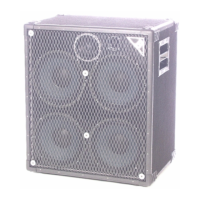original system through passive equalization. Extensive passive EQ is difficult, because it has a way of
op too low for most amplifiers to handle. The job was devilishly difficult, but in
the end was quite successful.)
other changes which distinguish the Low B Series II from the original? Several things.
The distinctive metal edges which gave
our speakers such a conspicuous appearance were considered
important in the early days of the company because, frankly, we were
trying to be noticed. This isn’t a
concern any more. In fact, we have heard of TV producers who actually balk at the idea of hav
glaring piece on their soundstage.
After we upgraded the bare metal screens to a powder
coated finished version, i
preventative, it became clear that eventually the metal edges would benefit from a similar treatment. The
es II models have a new charcoal black powder
coated steel edge protector. Better.
The original Low B crossovers had a design d
rawback which has been corrected in the new models. The
attenuators, which control the output of the midrange and tweeter were u
nprotected. In cases of stupidity
4%) it was possible to burn one or both attenuators out. It had never oc
me that this would be a problem, and even though it has been an unusual occurrence, it has been
ng for manufacturer and customer alike.
Not any more, however. We found a way to add a component to the crossover which actual
itself gradually into the circuit as the attenuation is increased, and it is now all but impossible to damage
the attenuators. The trade
off is that the midrange and tweeter output can only be reduced by 20 dB,
which is equal to 99% power
reduction, instead of being totally shut
Another change which has been made to the crossover is that instead of being su
input jacks, as before, the Low B now comes equipped with a single 1/4” jack, banana jacks, and a
Speakon connector. Both banana and Speakon provide greater electrical integrity than the more common
and the industry seems to be aware of this, so I’ve decided to jump on this
Handles. I’ve been internationally cond
emned and universally chastised for my choice of small, recessed
handles for the Low B systems, particularly in the case of the
4 unit. (See section on Handles later
in this publication.) I know when I’m licked. I admit that the handles I’ve used o
useless, other than providing internal support for the ports, and I’ve caved in to popular demand
4 Series II now has larger, heavier, and more useful handles. It’s the best example of this type of
to find, and they aren’t cheap. The B
2 still has the small recessed handle, because it
hasn’t been such a problem with this sm
1 is equipped with a Fender
type strap handle. It is a great handle in terms of preserving
egrity, and serves the second function of helping avoid obstruction of the speaker’s side
mounted port. More on this below.

